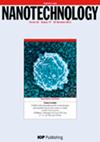Fabrication of a Graphene@Ni foam-supported silver nanoplates-PANI 3D architecture electrode for enzyme-free glucose sensing.
IF 2.9
4区 材料科学
Q3 MATERIALS SCIENCE, MULTIDISCIPLINARY
引用次数: 0
Abstract
Reliable and cost-effective glucose sensors are in rising demand among diabetes patients. The combination of metals and conducting polymers creates a robust electrocatalyst for glucose oxidation, offering enzyme-free, high stability, and sensitivity with outstanding electrochemical results. Herein, graphene is grown on nickel foam by chemical vapor deposition to make a graphene@nickel foam scaffold (G@NF), on which silver nanoplates-polyaniline (Ag-PANI) 3D architecture is developed by sonication-assisted co-electrodeposition. The resulting binder-free 3D Ag-PANI/G@NF electrode was highly porous, as characterized by XPS, FESEM, XRD, FTIR, and Raman spectroscopy. The binder-free 3D Ag-PANI/G@NF electrode exhibits remarkable electrochemical efficiency with a superior electrochemical active surface area. The amperometric analysis provides excellent anti-interference performance, a low limit of deduction (0.1 nM), robust sensitivity (1.7 x 1013 µA mM-1cm-2), and a good response time. Moreover, the Ag-PANI/G@NF enzyme-free sensor is utilized to observe glucose levels in human blood serums and exhibits excellent potential to become a reliable clinical glucose sensor.制备用于无酶葡萄糖传感的石墨烯@镍泡沫支撑银纳米板-PANI 三维结构电极。
糖尿病患者对可靠且经济高效的葡萄糖传感器的需求不断增加。金属与导电聚合物的结合创造了一种强大的葡萄糖氧化电催化剂,具有无酶、高稳定性、高灵敏度和出色的电化学效果。在本文中,通过化学气相沉积法在泡沫镍上生长石墨烯,制成石墨烯@泡沫镍支架(G@NF),并通过超声辅助共电泳法在其上开发出纳米银-聚苯胺(Ag-PANI)三维结构。通过 XPS、FESEM、XRD、傅立叶变换红外光谱(
FTIR)和拉曼光谱表征,得到的无粘结剂三维 Ag-PANI/G@NF 电极具有高多孔性。无粘合剂三维 Ag-PANI/G@NF 电极具有优异的电化学活性表面积,电化学效率极高。安培分析法具有优异的抗干扰性能、较低的扣除极限(0.1 nM)、灵敏度高(1.7 x 1013 µA mM-1cm-2)以及响应时间短等特点。此外,Ag-PANI/G@NF 无酶传感器还可用于观测人体血清中的葡萄糖水平,具有成为可靠的临床葡萄糖传感器的巨大潜力。
本文章由计算机程序翻译,如有差异,请以英文原文为准。
求助全文
约1分钟内获得全文
求助全文
来源期刊

Nanotechnology
工程技术-材料科学:综合
CiteScore
7.10
自引率
5.70%
发文量
820
审稿时长
2.5 months
期刊介绍:
The journal aims to publish papers at the forefront of nanoscale science and technology and especially those of an interdisciplinary nature. Here, nanotechnology is taken to include the ability to individually address, control, and modify structures, materials and devices with nanometre precision, and the synthesis of such structures into systems of micro- and macroscopic dimensions such as MEMS based devices. It encompasses the understanding of the fundamental physics, chemistry, biology and technology of nanometre-scale objects and how such objects can be used in the areas of computation, sensors, nanostructured materials and nano-biotechnology.
 求助内容:
求助内容: 应助结果提醒方式:
应助结果提醒方式:


